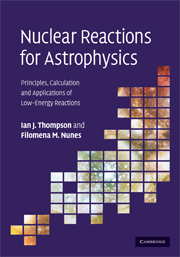Book contents
- Frontmatter
- Contents
- Preface
- Sources of quotations
- Acknowledgements
- 1 Nuclei in the Cosmos
- 2 Reactions of nuclei
- 3 Scattering theory
- 4 Reaction mechanisms
- 5 Connecting structure with reactions
- 6 Solving the equations
- 7 Approximate solutions
- 8 Breakup
- 9 Three-body nuclei
- 10 R-matrix phenomenology
- 11 Compound-nucleus averaging
- 12 Stellar reaction rates and networks
- 13 Connection to experiments
- 14 Spectroscopy
- 15 Fitting data
- Appendix A Symbols
- Appendix B Getting started with Fresco
- Select bibliography
- Index
9 - Three-body nuclei
Published online by Cambridge University Press: 05 March 2012
- Frontmatter
- Contents
- Preface
- Sources of quotations
- Acknowledgements
- 1 Nuclei in the Cosmos
- 2 Reactions of nuclei
- 3 Scattering theory
- 4 Reaction mechanisms
- 5 Connecting structure with reactions
- 6 Solving the equations
- 7 Approximate solutions
- 8 Breakup
- 9 Three-body nuclei
- 10 R-matrix phenomenology
- 11 Compound-nucleus averaging
- 12 Stellar reaction rates and networks
- 13 Connection to experiments
- 14 Spectroscopy
- 15 Fitting data
- Appendix A Symbols
- Appendix B Getting started with Fresco
- Select bibliography
- Index
Summary
One never notices what has been done; one can only see what remains to be done.
Marie CurieThe direct reaction of a two-body projectile with a target constitutes a three-body problem, as discussed in the previous chapter. The next most complicated group of processes involve a three-body projectile, which with a target make a four-body reaction problem. This group includes reactions where the projectile is a two nucleon halo nucleus, and in this chapter we present theories for the structure and reactions of such nuclei. First we introduce the topic of halo nuclei, then describe three-body models for bound and scattering states. Finally we discuss four-body reaction models within DWBA, the adiabatic approximation and the eikonal approximation, and conclude by looking at four-body CDCC.
Definitions of halo and deeply bound states
Stable nuclei are characterized by large binding energies and extremely long lifetimes. Figure 9.1 shows the nuclear chart for light nuclei. As we add protons or neutrons to the system, and move away from the valley of stability (black squares in Fig. 9.1), the binding energy of the valence nucleons becomes smaller and smaller until eventually the system can no longer bind. Around the nuclear dripline, we frequently find exotic structures called halo nuclei [1]. The halo phenomenon comes from a significant decoupling of the valence nucleon (or nucleons) from the remaining nucleons, which form a core.
- Type
- Chapter
- Information
- Nuclear Reactions for AstrophysicsPrinciples, Calculation and Applications of Low-Energy Reactions, pp. 274 - 295Publisher: Cambridge University PressPrint publication year: 2009



